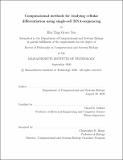Computational methods for studying cellular differentiation using single-cell RNA-sequencing
Author(s)
Yeo, Hui Ting Grace.
Download1227507551-MIT.pdf (35.25Mb)
Other Contributors
Massachusetts Institute of Technology. Computational and Systems Biology Program.
Advisor
David K. Gifford.
Terms of use
Metadata
Show full item recordAbstract
Single-cell RNA-sequencing (scRNA-seq) enables transcriptome-wide measurements of single cells at scale. As scRNA-seq datasets grow in complexity and size, more complex computational methods are required to distill raw data into biological insight. In this thesis, we introduce computational methods that enable analysis of novel scRNA-seq perturbational assays. We also develop computational models that seek to move beyond simple observations of cell states toward more complex models of underlying biological processes. In particular, we focus on cellular differentiation, which is the process by which cells acquire some specific form or function. First, we introduce barcodelet scRNA-seq (barRNA-seq), an assay which tags individual cells with RNA 'barcodelets' to identify them based on the treatments they receive. We apply barRNA-seq to study the effects of the combinatorial modulation of signaling pathways during early mESC differentiation toward germ layer and mesodermal fates. Using a data-driven analysis framework, we identify combinatorial signaling perturbations that drive cells toward specific fates. Second, we describe poly-adenine CRISPR gRNA-based scRNA-seq (pAC-seq), a method that enables the direct observation of guide RNAs (gRNAs) in scRNA-seq. We apply it to assess the phenotypic consequences of CRISPR/Cas9-based alterations of gene cis-regulatory regions. We find that power to detect transcriptomic effects depend on factors such as rate of mono/biallelic loss, baseline gene expression, and the number of cells per target gRNA. Third, we propose a generative model for analyzing scRNA-seq containing unwanted sources of variation. Using only weak supervision from a control population, we show that the model enables removal of nuisance effects from the learned representation without prior knowledge of the confounding factors. Finally, we develop a generative modeling framework that learns an underlying differentiation landscape from population-level time-series data. We validate the modeling framework on an experimental lineage tracing dataset, and show that it is able to recover the expected effects of known modulators of cell fate in hematopoiesis.
Description
Thesis: Ph. D., Massachusetts Institute of Technology, Computational and Systems Biology Program, 2020 Cataloged from student-submitted PDF of thesis. Includes bibliographical references (pages 159-176).
Date issued
2020Department
Massachusetts Institute of Technology. Computational and Systems Biology ProgramPublisher
Massachusetts Institute of Technology
Keywords
Computational and Systems Biology Program.